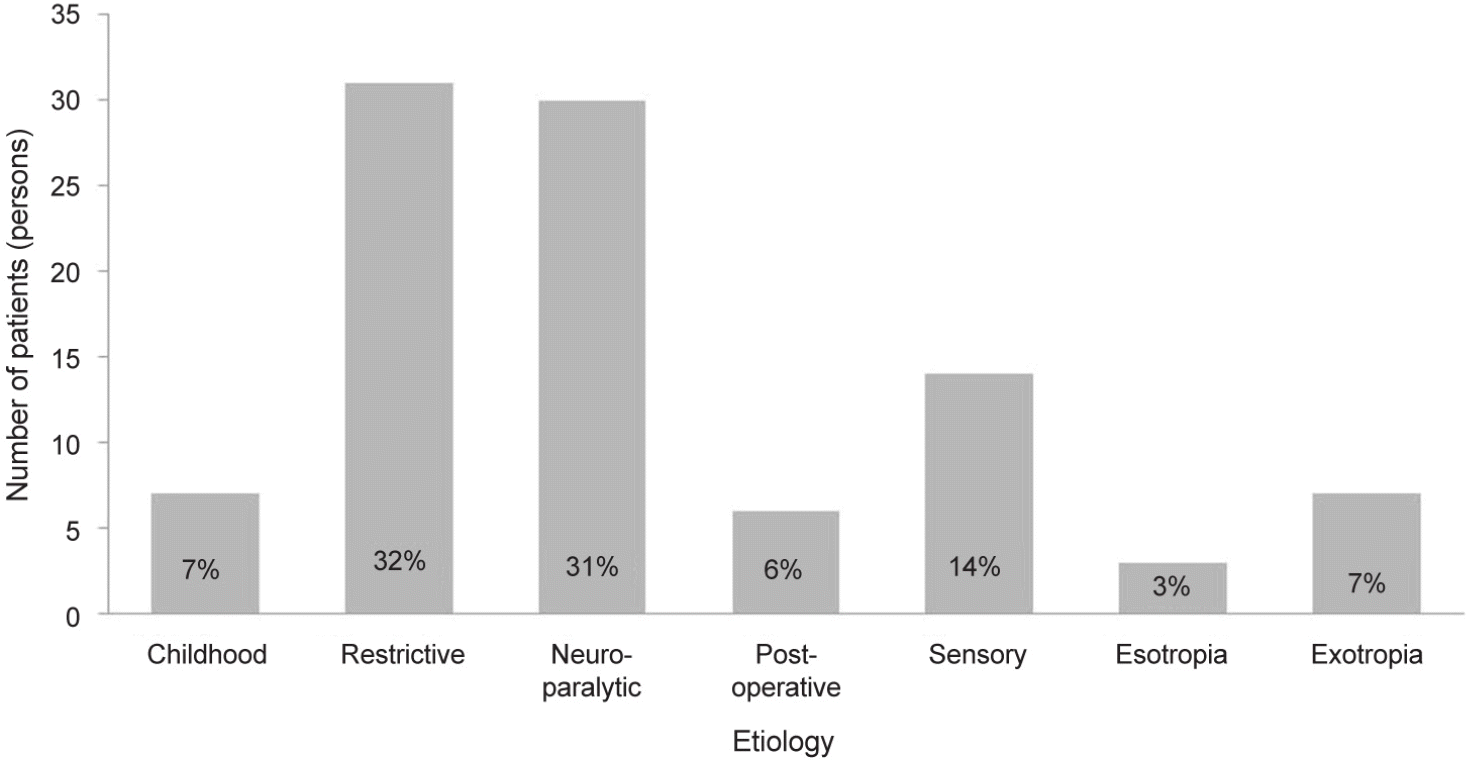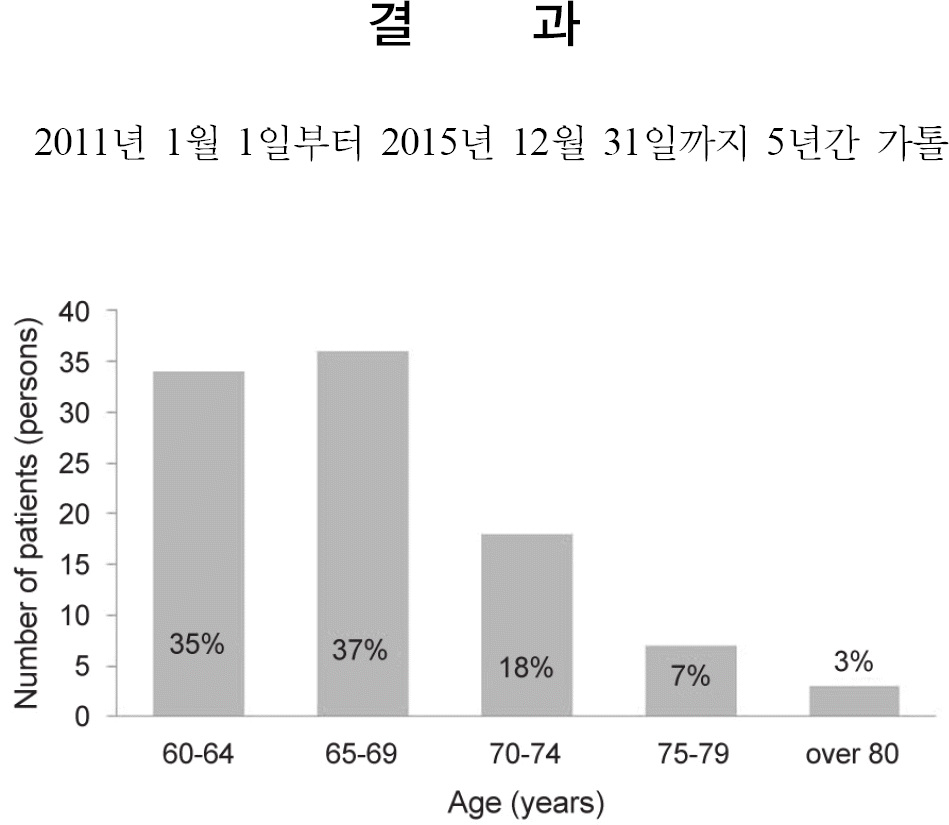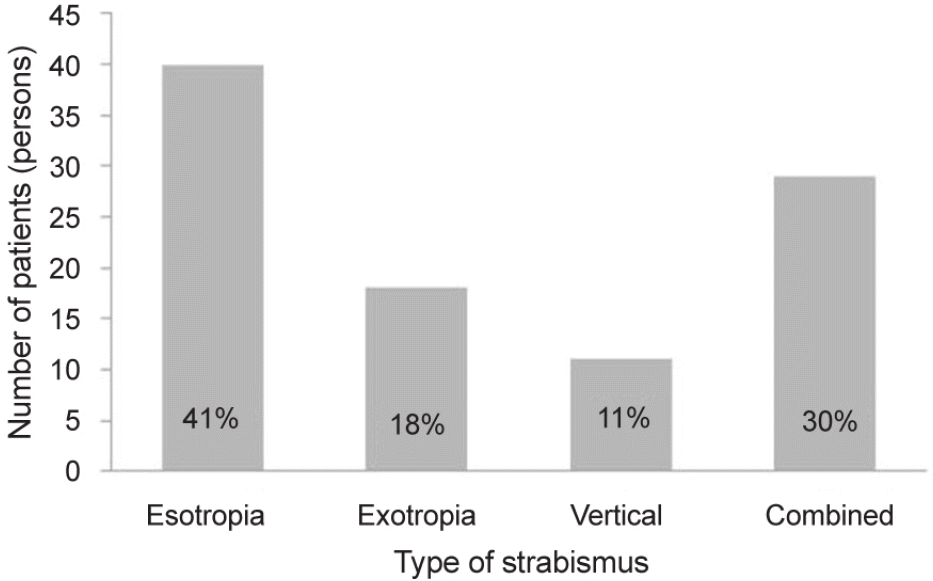Abstract
Purpose
In recent years, there has been an increase in the number of strabismus operations performed on patients aged 60 years and over. This study aims to establish the characteristics and outcomes of old age strabismus.
Methods
Patients aged 60 years and over who underwent strabismus surgery between January 2011 and December 2015 were included in this study. The purpose of surgery, type of strabismus, etiology, postoperative recurrence, prevalence of general and ocular complications, and postoperative diplopia rate were reviewed.
Results
Ninety-eight patients aged 60 years or older were identified, and 58.2% of patients had strabismus surgery to improve diplopia, while 41.8% chose surgery for cosmetic purposes. Esotropia was the most common type of strabismus found in 40.8% of the patients, and horizontal-vertical combined type was the second highest at 29.6%. The etiology of strabismus was similarly high in both the restrictive pattern (31.6%) and neuro-paralytic pattern (30.6%). The recurrence rate after strabismus surgery was 4.1%, and the reoperation rate was 3.1%. The remnant diplopia rate after surgery in patients with diplopia was 15.8%, and the diplopia occurring rate in patients who underwent surgery for cosmetic purposes was 4.9%. No severe ocular complications such as anterior segment syndrome or eyeball rupture occurred. Anesthesia related problems did not occur in any of the patients who underwent general anesthesia.
Go to : 
References
1. Statistics Korea . . 2015~2065 Future population estimates. Daejeon: Statistics Korea. 2016.
2. Astle AT, Foulsham T, Foss AJ, McGraw PV. . Is the frequency of adult strabismus surgery increasing? Ophthalmic Physiol Opt. 2016; 36:487–93.
3. Kim CS, Lee CS, Lee CY, Ji NC. . A clinical survey of strabismus in children. J Korean Ophthalmol Soc. 1994; 35:1253–61.
4. Maino AP, Dawson EM, Lee JP. . Strabismus surgery in the over 60s–an update. Strabismus. 2011; 19:1–4.
5. Imburgia A, Elia G, Franco F. . Treatment of exophthalmos and strabismus surgery in thyroid-associated orbitopathy. Int J Oral Maxillofac Surg. 2016; 45:743–9.

6. Ganekal S, Nagarajappa A. . Strabismus following scleral buckling surgery. Strabismus. 2016; 24:16–20.

7. Chang JH, Hutchinson AK, Zhang M, Lambert SR. . Strabismus surgery outcomes after scleral buckling procedures for retinal reattachment. Strabismus. 2013; 21:235–41.

8. Chaudhry NL, Durnian JM. . Post-vitreoretinal surgery stra-bismus-a review. Strabismus. 2012; 20:26–30.

9. Farr AK, Guyton DL. . Strabismus after retinal detachment surgery. Curr Opin Ophthalmol. 2000; 11:207–10.

10. Seaber JH, Buckley EG. . Strabismus after retinal detachment sur-gery: etiology, diagnosis, and treatment. Semin Ophthalmol. 1995; 10:61–73.

11. Maurino V, Kwan A, Khoo BK. . Ocular motility disturbances after surgery for retinal detachment. J AAPOS. 1998; 2:285–92.

12. Smiddy WE, Loupe D, Michels RG. . Extraocular muscle im-balance after scleral buckling surgery. Ophthalmology. 1989; 96:1485–9. discussion 1489-90.

13. Guo S, Wagner R, Gewirtz M. . Diplopia and strabismus fol-lowing ocular surgeries. Surv Ophthalmol. 2010; 55:335–58.

14. Wright LA, Cleary M, Barrie T, Hammer HM. . Motility and binoc-ularity outcomes in vitrectomy versus scleral buckling in retinal detachment surgery. Graefes Arch Clin Exp Ophthalmol. 1999; 237:1028–32.

15. Kushner BJ. . The benefits, risks, and efficacy of strabismus surgery in adults. Optom Vis Sci. 2014; 91:e102–9.

16. Pratt-Johnson JA, Tillson G, Pop A. . Suppression in strabismus and the hemiretinal trigger mechanism. Arch Ophthalmol. 1983; 101:218–24.

17. Scott WE, Kutschke PJ, Lee WR. . 20th annual frank costenbader lecture–adult strabismus. J Pediatr Ophthalmol Strabismus. 1995; 32:348–52.

18. Kushner BJ. . Intractable diplopia after strabismus surgery in adults. Arch Ophthalmol. 2002; 120:1498–504.

19. Wan MJ, Hunter DG. . Complications of strabismus surgery: in-cidence and risk factors. Semin Ophthalmol. 2014; 29:421–8.

20. Olitsky SE, Coats DK. . Complications of strabismus surgery. Middle East Afr J Ophthalmol. 2015; 22:271–8.

21. Mills MD, Coats DK, Donahue SP, Wheeler DT. . Strabismus surgery for adults: a report by the American Academy of Ophthalmology. Ophthalmology. 2004; 111:1255–62.
22. Satterfield D, Keltner JL, Morrison TL. . Psychosocial aspects of strabismus study. Arch Ophthalmol. 1993; 111:1100–5.

23. Burke JP, Leach CM, Davis H. . Psychosocial implications of strabismus surgery in adults. J Pediatr Ophthalmol Strabismus. 1997; 34:159–64.

24. Durnian JM, Noonan CP, Marsh IB. . The psychosocial effects of adult strabismus: a review. Br J Ophthalmol. 2011; 95:450–3.

25. Kim SA, Yim HB. . Quality of life after strabismus surgery. J Korean Ophthalmol Soc. 2013; 54:1407–15.

Go to : 
 | Figure 3.Etiology of strabismus in patients over 60 years. Restrictive pattern and neuroparalytic pattern hold a majority of etiology. |
Table 1.
Patient's purpose of strabismus surgery
| Sex | Number of patients | |
|---|---|---|
| Cosmetic | Diplopia | |
| Male | 15 | 36 |
| Female | 26 | 21 |
| Total | 41 | 57 |
Table 2.
Subtype of strabismus according to etiology
Table 3.
Purpose of surgery according to etiology




 PDF
PDF ePub
ePub Citation
Citation Print
Print




 XML Download
XML Download